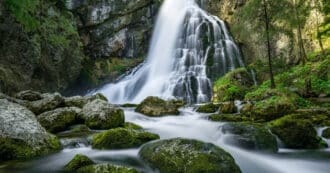The Rev. Dr. Leah D. Schade; leahschade@gmail.com
Here are ideas for reading and preaching about “a new heaven and earth” in Revelation 21:1-6. This is part of the EcoPreacher 1-2-3 series to equip pastors and congregations for engaging the Bible through an ecological lens.
Some interpret the apocalyptic vision of “a new heaven and a new earth” in Revelation to mean that we are free to exploit and degrade the Earth today. Nothing could be further from the truth. In fact, the prophecy compels us to embrace an ethic of environmental justice.
Revelation 21:1: Then I saw a new heaven and a new earth; for the first heaven and the first earth had passed away, and the sea was no more.
Eco-Exegesis
Eco-exegesis is a method of interpreting the biblical text through a green lens using the principles of ecological theology. For this passage, we turn to Chapter 11 of the book, Apocalypse When: A Guide to Interpreting and Preaching Apocalyptic Texts, that I co-wrote with my colleague Jerry Sumney, Professor of Biblical Studies at Lexington Theological Seminary.
“A new heaven and a new earth” may sound to some like an advertisement about a product that is “new and improved” in our consumerist economy. This kind of thinking contributes to frantic accumulation and reckless disposal. It’s a cycle that alternatingly strips and chokes our planet and vulnerable communities with overconsumption and pollution. But, as Eugene Boring notes, “God does not make ‘all new things,’ but ‘all things new.’”1 In other words, John’s apocalyptic vision is about renewal rather than replacement. John’s is a new vision for Creation, but intimately related to the previous one.
The image of a new heaven and a new earth is also found in Isaiah 65:17, a text that describes the final glorious restoration of Jerusalem and the people of God. This suggests that God is concerned about Creation, as the new is constructed out of the old. As we contemplate the reality that humans have the capacity to destroy Creation on a scale unforeseen by John, it seems clear that his vision for the eschaton was for humans to be God’s partners on this planet, respecting and caring for Earth. If God’s plan involves the reclamation of God’s good creation (see also Romans 8:19–23), then believers, as those who seek God’s will, should be involved in this task as well. Revelation’s description of this wonderful salvation is an exhortation to faithfulness in doing God’s will.
Further, as Sumney notes, God is not abandoning the original creation; the New Jerusalem is coming down to where the people are. This coming down of the New Jerusalem also means that the saved are not taken up from this world. While other imagery in the New Testament has imagery of going up, here God brings the salvation to the people and Creation.
In v. 3, an unidentified voice from God’s throne says God’s “tent” (skēnos) will be among the people. This is the terminology that the Septuagint (the Greek translation of the Hebrew Bible) used for the tabernacle the Israelites had in their wilderness wandering. It is also the language the Gospel of John uses to describe the incarnation in 1:14. The image intends to convey the closest proximity possible. God will live directly with the people. They are fully God’s people and fully in God’s presence. In that presence, God fully claims them as God’s own.
But what about the sea being “no more”? The sea was a symbol of chaos and rebellion against God. But in the fullness of time, such powers no longer threaten God’s people, or even exist. In contrast, we have the vision of the spring of water that gives life (v. 6). “Living water” is the expression in Greek for what we call “running water.” In this passage, it also means water that gives eternal life, as it did in Jesus’s conversation with the Samaritan woman in John 4:10–15. Thus, this passage about “a new heaven and a new earth,” is hopeful, confident, and enthusiastic about the future in light of God’s promises.
1. Eco-Idea
The Eco-Idea is one succinct statement that tells us who God is and/or what God does in relation to Creation and how we should respond as people of faith.
As we trust God’s promise of a “new heaven and a new earth,” the church’s work in Creation care is consistent with what God wants for the world now and what God will bring about for all Creation in the fulfillment of time.
2. Eco-Questions
Eco-Questions are what we can ask to help a congregation draw out the implications of the Eco-Exegesis and Eco-Idea.
- What are ways that our congregation can be involved in the task of reclaiming and renewing God’s good Creation? What might this renewal look like in our time and place, in our particular ecosystem, given the environmental problems in our community?
- What are the ramifications for seeing Earth itself as God’s temple? How might Creation be a site of sacredness as God’s dwelling place—even if this sacred temple has been defiled and needs our attention in cleaning it up?
3. Eco-Actions
Eco-Actions are ways that a congregation might respond to the Eco-Idea and Eco-Questions. One of these possibilities may have salience for your ministry context.
- Identify a local waterway that is in need of cleaning up from pollution and trash. Create a service project for older children, youth, and adults to join with local efforts to remove garbage and restore the beauty of a creek, river, lake, or ocean.
- Invite your congregation to contribute to efforts for creating potable water sources in drought-prone places. Many denominations have faith-based water ministries, and there are organizations such as https://www.charitywater.org/, https://www.bloodwater.org/, and https://water.org/ that focus on sanitation and clean water around the world.
- Celebrate the precious gift of water with an affirmation of baptism that reminds the congregation of our baptismal vocation to protect the cleansing, renewing waters of this Earth.
1 Eugene Boring, Revelation, 220. Cited by Brian K. Blount, Revelation: A Commentary, 376.
* Featured image source





